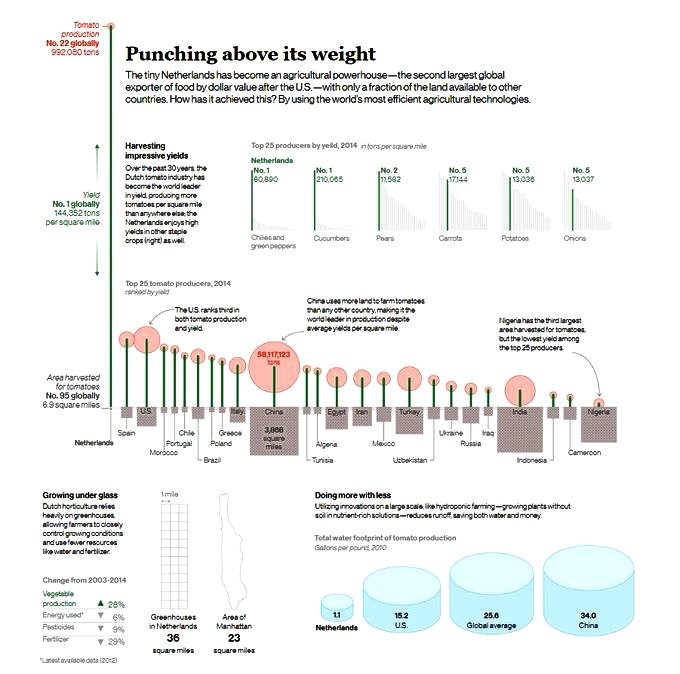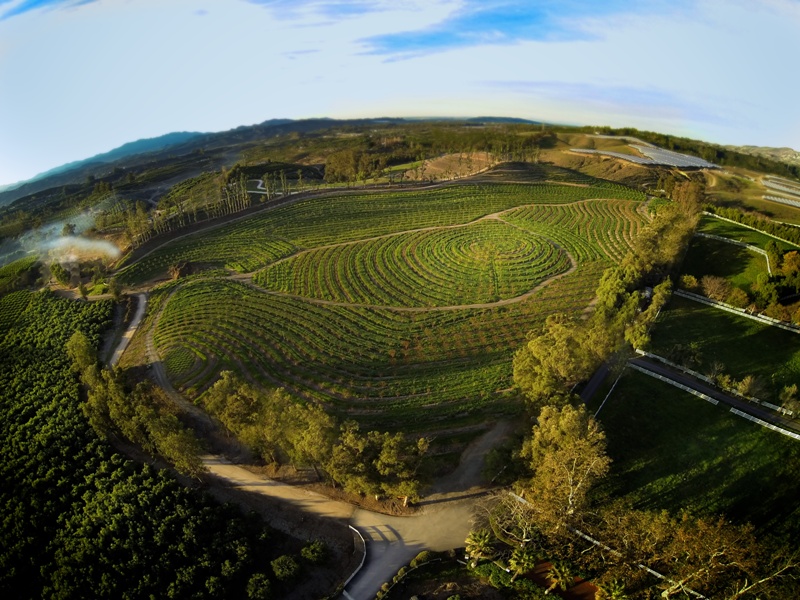Alternative Agriculture
The Netherlands: This tiny country feeds the world
- Agricultural giant Holland is changing the way we farm
Almost two decades ago, the Dutch made a national commitment to sustainable agriculture under the rallying cry “Twice as much food using half as many resources.” Since 2000, van den Borne and many of his fellow farmers have reduced dependence on water for key crops by as much as 90 percent. They’ve almost completely eliminated the use of chemical pesticides on plants in greenhouses, and since 2009 Dutch poultry and livestock producers have cut their use of antibiotics by as much as 60 percent.
One more reason to marvel: The Netherlands is a small, densely populated country, with more than 1,300 inhabitants per square mile. It’s bereft of almost every resource long thought to be necessary for large-scale agriculture. Yet it’s the globe’s number two exporter of food as measured by value, second only to the United States, which has 270 times its landmass.
How on Earth have the Dutch done it?
Read the story in National Geographic
🌎
In California
The Biggest Little Farm
🌎
In France
Exploring ecologically sound food growing practices
🌎
In the US
Did you know that Organic food is now a $56 billion market in the United States, but it only represents 6% of all U.S. food sales? (2022)
The Regenerative-Organic food sector is growing ... Be healthy, be sustainable, go green and support regenerative ag.
Regenerative Ag Meets Regenerative Watersheds and River Basins
Local, Regional and Global 'Green Best Practices'
🌎
Regeneration Ag / Globally
1000 Landscapes for 1 Billion People
Regenerative Agriculture in Europe, by Richard Perkins
🌎
Greening Agriculture / Eco-Agriculture: Greening the Fields
-- From The Little Green Book @GreenPolicy360
Environmentally-friendly agriculture/farming/gardening/green best practices
- Resources
Agroecological Farming http://www.greenpolicy360.net/w/Agroecological_Farming
‘A more environmentally and socially sensitive approach to agriculture, one that focuses not only on production, but also on the ecological sustainability of the productive system.’
Agroforestry https://www.greenpolicy360.net/w/Agroforestry
'Agroforestry refers to the practice of growing trees combined with crops and/or animals in ways that create benefits from their interactions.'
Biodynamic Agriculture https://www.biodynamics.com/nabdap-participating-mentor-farms - Biodynamic farms map/US
‘Concept and practices of Dr. Rudolph Steiner emphasizing forces within living nature…’
Biointensive Gardening http://growbiointensive.org/ - http://en.wikipedia.org/wiki/Biointensive_agriculture
‘John Jeavons and Ecology Action have refined a production system that makes it possible for one person to grow all of his or her family's food using truly sustainable methods that maintain the fertility of the soil without relying on nonrenewable resources like petrochemicals or imported organic matter.’
Biological Farming http://www.farmersweekly.co.za/article.aspx?id=41852&h=Biological-farming---it-works-for-them! - http://www.harlequinsgardens.com/mikls-articles/biological-farming-gardening/ - http://www.acresusa.com/events/2014ecoagu
‘Biological and Ecological Farming are terms commonly used in Europe and developing countries… Biological farming are systems of crop production in which the producer tries to minimize the use of 'chemicals' for control of crop pests, emphasizing sustainability.’
Carbon Farming Agricultural practices that maximize carbon sequestration http://www.greenpolicy360.net/w/Carbon_Sequestration
Climate Smart Agriculture http://www.greenpolicy360.net/w/Climate_Smart_Agriculture
‘Agriculture practices designed to be sustainable while minimizing damaging impacts of the environment.’
Community Supported Agriculture http://www.localharvest.org/csa/ - http://www.localharvest.org/organic-farms/ - Local Farms - Maps There are almost two million farms in the USA. About 80% of those are small farms, and a large percentage are family owned. More and more of these farmers are now selling their products directly to the public. They do this via CSA programs, Farmers' Markets, Food Coops, u-picks, farm stands, and other direct marketing channels.
‘CSA’s consist of a community of individuals who pledge support to a farm operation so that the farmland becomes, either legally or spiritually, the community's farm, with the growers and consumers providing mutual support and sharing the risks and benefits of food production.’
Natural Farming http://en.wikipedia.org/wiki/Natural_farming
‘Natural Farming reflects the experiences and philosophy of Japanese farmer Masanobu Fukuoka…’
Organic Farming http://en.wikipedia.org/wiki/Organic_farming
Organic farming was championed in the United States by J.I. Rodale, beginning in the mid-1940s. "The organic farmer and gardener must realize that fertilization is not the only measure for success. He must treat the soil as a living, breathing entity. He must rotate crops. He must fallow the land at regulated intervals. The organiculturist must not practice one-crop monoculture but must engage in a balanced agriculture with cattle as part of the general program. He must be smart in the ways of soil and crops, observing the reaction of the land to the actions of man. For instance, he must know when to plant, when to harvest, and what varieties of seed to use. Compost alone does not make a successful gardener any more than does gardening without compost." ["The Organiculturist’s Creed," in The Organic Front]
As defined by a USDA Study Team on Organic Farming, "Organic farming is a production system which avoids or largely excludes the use of synthetically compounded fertilizers, pesticides, growth regulators, and livestock feed additives.
The following definition was drafted and passed by the USDA National Organic Standards Board (NOSB) in April 1995. It was developed by a joint NOSB/National Organic Program task force, and incorporated language from the Codex Draft Guidelines for organically produced foods: "Organic agriculture is an ecological production management system that promotes and enhances biodiversity, biological cycles and soil biological activity. It is based on minimal use of off-farm inputs and on management practices that restore, maintain and enhance ecological harmony. ‘Organic’ is a labeling term that denotes products produced under the authority of the Organic Foods Production Act. The principal guidelines for organic production are to use materials and practices that enhance the ecological balance of natural systems and that integrate the parts of the farming system into an ecological whole.”
"Organic food is produced by farmers who emphasize the use of renewable resources and the conservation of soil and water to enhance environmental quality for future generations. Organic meat, poultry, eggs, and dairy products come from animals that are given no antibiotics or growth hormones. Organic food is produced without using most conventional pesticides; fertilizers made with synthetic ingredients or sewage sludge; bioengineering; or ionizing radiation. Before a product can be labeled "organic," a Government-approved certifier inspects the farm where the food is grown to make sure the farmer is following all the rules necessary to meet USDA organic standards. Companies that handle or process organic food before it gets to your local supermarket or restaurant must be certified, too." [What is organic food? (USDA, Agricultural Marketing Service, National Organic Program (NOP))]
Permaculture http://www.greenpolicy360.net/w/Permaculture_Green_Practices
‘A contraction of "permanent agriculture," the word "permaculture" was coined by Australian Bill Mollison in the late 1970s. One of the many alternative agriculture systems described as sustainable, permaculture is "unique in its emphasis on design; that is, the location of each element in a landscape, and the evolution of landscape over time. The goal of permaculture is to produce an efficient, low-maintenance integration of plants, animals, people and structure... applied at the scale of a home garden, all the way through to a large farm." [John Quinney, "Permaculture in the United States.]’
Regenerative Agriculture http://en.wikipedia.org/wiki/Regenerative_agriculture
‘Robert Rodale coined this term, and it subsequently was expanded to "regenerative/sustainable agriculture" by the Rodale Institute and Rodale Research Center.’
Regenerative ag has expanded in 2015 with 'climate smart' activism -- http://www.kisstheground.com/why-soil/
- http://www.greenpolicy360.net/w/Regenerative_Agriculture
- http://www.greenpolicy360.net/mw/images/Soil_Story_AnnotatedScript_2015.pdf
Seed Saving http://blog.seedsavers.org/blog/40-reasons-to-save-seeds
Silvopasture https://en.m.wikipedia.org/wiki/Silvopasture
Silvopasture (Latin, silva forest) is the practice of integrating trees, forage, and the grazing of domesticated animals in a mutually beneficial way. It utilizes the principles of managed grazing, and it is one of several distinct forms of agroforestry.
Sustainable Agriculture http://en.wikipedia.org/wiki/Sustainable_agriculture
‘Agriculture within a system of sustainable development looks to ... "meet the needs of the present without compromising the ability of future generations to meet their own needs." [The World Commission on Environment and Development].’
Self-sustaining Farming Self-sustaining farm and urban-farm video tutorials
‘Small-scale’, ‘micro-farming intended to produce enough food for self-sufficient living. Often less than an acre up to five acre size farms.’
Small Plot Intensive http://www.spinfarming.com/buy/pick-your-farm-model
Vertical Gardening http://www.permaculture.co.uk/articles/vertical-gardening-great-small-spaces
-=-=-=-=-=-=-=-=-=-=-=-=-=-=-=-=-=-=-=-=-=-=-=-=-=-=-=-=-=-=-=-
Dig Deeper in Alternative Ag at GreenPolicy360
Food & Politics / Health / Sustainability / Water
Agriculture
-=-=-=-=-=-=-=-=-=-=-=-=-=-
- Silvopasture Ag
“This is about not doing monoculture,” says Martin Anderton... “We’re letting nature work.”
Mr. Jono Neiger and Mr. Anderton are practitioners of “silvopasture,” a system of managed grazing, livestock farming, and tree cultivation. It is an old way of doing agriculture, but one that became rare in modern American farming. Now, though, a broad and growing group of agriculture officials, farmers, and climate activists are promoting silvopasture. Not only does it increase soil health and productivity, they say, but it also pulls carbon out of the atmosphere – lots of it.
Project Drawdown, a nonprofit research group focused on climate, ranked silvopasture as the ninth most impactful climate change solution in the world, above rooftop solar power, electric vehicles, and geothermal electricity. The group estimates that if farmers increased silvopasture acreage from approximately 351 million acres today to 554 million by 2050, carbon dioxide emissions could be reduced by 31.2 gigatons...
-=-
- Urban Gardening
Food, not Sod
http://growfood-notlawns.com/started-boxes-60-days-later-neighbors-not-believe-built/
-=-
Who Owns Organic Food Companies and Brands?
Corporate Acquisitions Multiply
File:Organic-chart-Jan-2016.pdf
https://www.cornucopia.org/wp-content/uploads/2016/01/Organic-chart-Jan-2016-1024x791.jpg
-=-
- Alternative Agriculture
- Agriculture
- Biodiversity
- Biogeosciences
- Bioneers
- Earth Law
- Earth Observations
- Earth Science
- Eco-nomics
- Ecology Studies
- Education
- Environmental Full-cost Accounting
- Environmental Security, National Security
- EOS eco Operating System
- Externalities
- Farm-Related Policies
- Food
- Food-Related Policies
- France
- Green Best Practices
- Green Politics
- Health
- Land Ethic
- Natural Capital
- Netherlands
- Organic Food
- Permaculture
- Planet Citizen
- Planet Citizens
- Planet Citizens, Planet Scientists
- Resilience
- Soil
- Sustainability
- Sustainability Policies
- Urban Gardening
- US
- Water
- Water Saving





